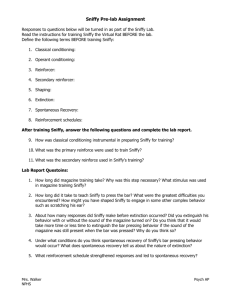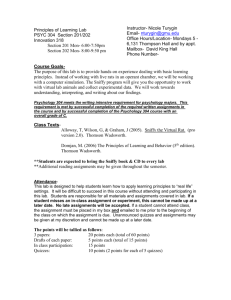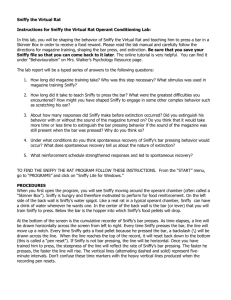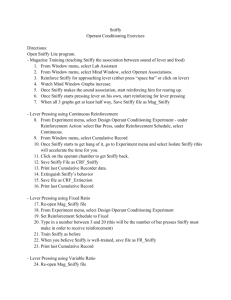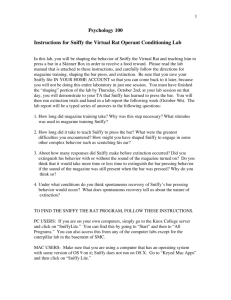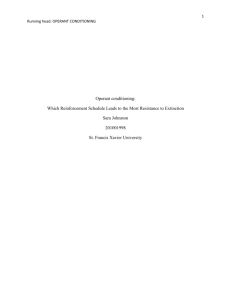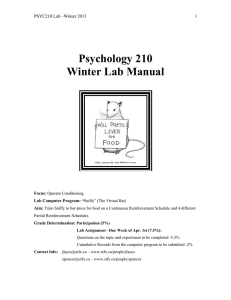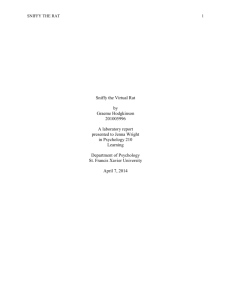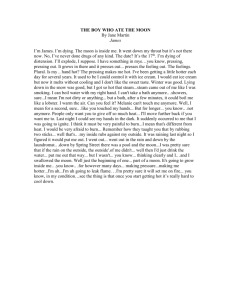education lab write up
advertisement
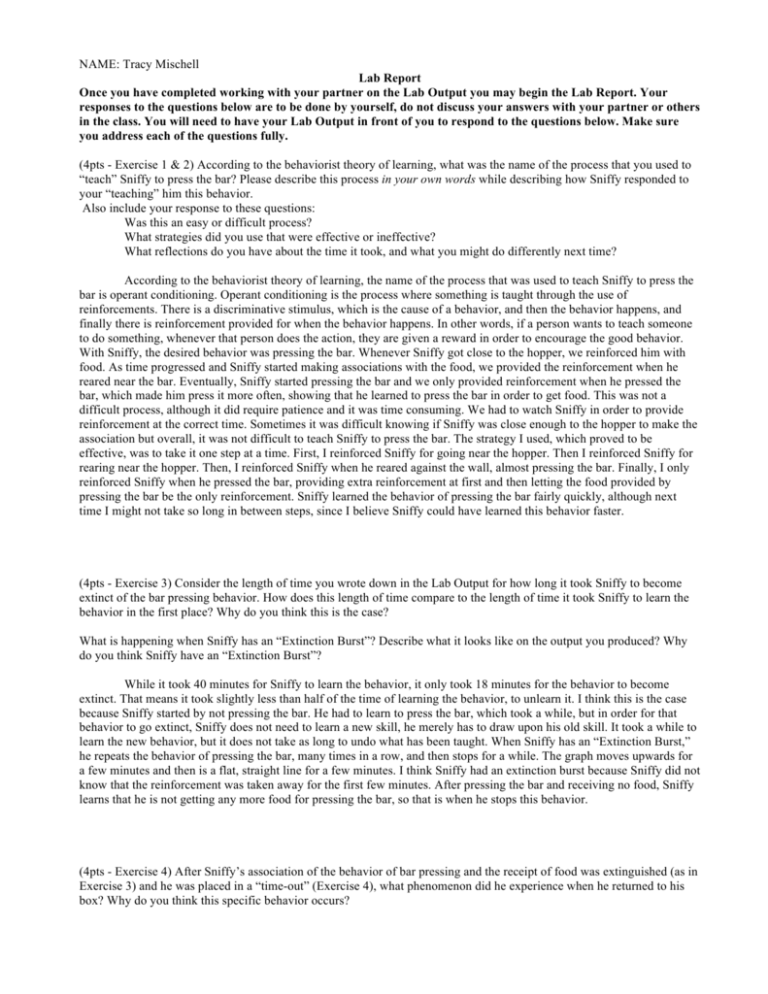
NAME: Tracy Mischell Lab Report Once you have completed working with your partner on the Lab Output you may begin the Lab Report. Your responses to the questions below are to be done by yourself, do not discuss your answers with your partner or others in the class. You will need to have your Lab Output in front of you to respond to the questions below. Make sure you address each of the questions fully. (4pts - Exercise 1 & 2) According to the behaviorist theory of learning, what was the name of the process that you used to “teach” Sniffy to press the bar? Please describe this process in your own words while describing how Sniffy responded to your “teaching” him this behavior. Also include your response to these questions: Was this an easy or difficult process? What strategies did you use that were effective or ineffective? What reflections do you have about the time it took, and what you might do differently next time? According to the behaviorist theory of learning, the name of the process that was used to teach Sniffy to press the bar is operant conditioning. Operant conditioning is the process where something is taught through the use of reinforcements. There is a discriminative stimulus, which is the cause of a behavior, and then the behavior happens, and finally there is reinforcement provided for when the behavior happens. In other words, if a person wants to teach someone to do something, whenever that person does the action, they are given a reward in order to encourage the good behavior. With Sniffy, the desired behavior was pressing the bar. Whenever Sniffy got close to the hopper, we reinforced him with food. As time progressed and Sniffy started making associations with the food, we provided the reinforcement when he reared near the bar. Eventually, Sniffy started pressing the bar and we only provided reinforcement when he pressed the bar, which made him press it more often, showing that he learned to press the bar in order to get food. This was not a difficult process, although it did require patience and it was time consuming. We had to watch Sniffy in order to provide reinforcement at the correct time. Sometimes it was difficult knowing if Sniffy was close enough to the hopper to make the association but overall, it was not difficult to teach Sniffy to press the bar. The strategy I used, which proved to be effective, was to take it one step at a time. First, I reinforced Sniffy for going near the hopper. Then I reinforced Sniffy for rearing near the hopper. Then, I reinforced Sniffy when he reared against the wall, almost pressing the bar. Finally, I only reinforced Sniffy when he pressed the bar, providing extra reinforcement at first and then letting the food provided by pressing the bar be the only reinforcement. Sniffy learned the behavior of pressing the bar fairly quickly, although next time I might not take so long in between steps, since I believe Sniffy could have learned this behavior faster. (4pts - Exercise 3) Consider the length of time you wrote down in the Lab Output for how long it took Sniffy to become extinct of the bar pressing behavior. How does this length of time compare to the length of time it took Sniffy to learn the behavior in the first place? Why do you think this is the case? What is happening when Sniffy has an “Extinction Burst”? Describe what it looks like on the output you produced? Why do you think Sniffy have an “Extinction Burst”? While it took 40 minutes for Sniffy to learn the behavior, it only took 18 minutes for the behavior to become extinct. That means it took slightly less than half of the time of learning the behavior, to unlearn it. I think this is the case because Sniffy started by not pressing the bar. He had to learn to press the bar, which took a while, but in order for that behavior to go extinct, Sniffy does not need to learn a new skill, he merely has to draw upon his old skill. It took a while to learn the new behavior, but it does not take as long to undo what has been taught. When Sniffy has an “Extinction Burst,” he repeats the behavior of pressing the bar, many times in a row, and then stops for a while. The graph moves upwards for a few minutes and then is a flat, straight line for a few minutes. I think Sniffy had an extinction burst because Sniffy did not know that the reinforcement was taken away for the first few minutes. After pressing the bar and receiving no food, Sniffy learns that he is not getting any more food for pressing the bar, so that is when he stops this behavior. (4pts - Exercise 4) After Sniffy’s association of the behavior of bar pressing and the receipt of food was extinguished (as in Exercise 3) and he was placed in a “time-out” (Exercise 4), what phenomenon did he experience when he returned to his box? Why do you think this specific behavior occurs? Consider the time Sniffy took to extinugish the behavior in Exercise 3, and compare that with how long it took to extinguish the behavior the second time (Exercise 4). Why do you think the two numbers compare the way that they do? After Sniffy’s association of the behavior of pressing the bar was extinguished, he was placed in a “time-out.” When Sniffy returned to his box, he continued to press the bar many times in a row, until he remembered that he was not going to get food. He then would press the bar, take a break, press the bar again, take another break, and continue in this pattern, pressing the bar fewer and fewer times in between each break until the behavior was extinguished again. I think Sniffy returned to the behavior of pressing the bar, after being removed from his box, because he had learned that pressing the bar was rewarded with food, and even though before he was removed from the box the food reward was taken away, he still remembered the reward so he tried pressing the bar again, hoping to receive food, again. It took almost the same amount of time to extinguish the behavior the second time as it took the first time. The first time, it took Sniffy 18 minutes to extinguish the behavior. The second time, it took 14 minutes. The second time took four minutes shorter to make the behavior extinct because Sniffy had already extinguished the behavior once. It took almost the same amount of time, however, because removing Sniffy forced the extinction process to almost start over. (8pts – Exercise 5) For each of the different types of reinforcement schedules, use the Lab Output you have provided for the “consistent pattern/end” to calculate how many bar presses occur in a 5 minute period (make sure you calculate the number of behaviors and not the number of times Sniffy was reinforced). Also identify which 5 minute interval you used to calculate the number of bar presses on the output (because the pattern is consistent, it doesn’t matter which 5 minute interval you use, it should be the same or similar for all of them). Variable Interval 5 – Bar Presses in 5 minutes: 125/Which interval used (1st, 2nd, etc.)?: 2nd Variable Ratio 5 – Bar Presses in 5 minutes: 300/ Which interval used (1st, 2nd, etc.)?: 2nd Fixed Interval 5 – Bar Presses in 5 minutes: 50/ Which interval used (1st, 2nd, etc.)?: 2nd Fixed Ratio 5 – Bar Presses in 5 minutes: 260/ Which interval used (1st, 2nd, etc.)?: 2nd Think about both the visual pattern you see on the output and the number of bar presses in the 5 minute period. How do they compare with what you would expect of the different schedules from what we discussed in class? Make sure you remark about each of the four schedules. In your response you can discuss the speed of bar pressing, and any pauses in behavior that may/may not occur. If the pattern/speed does not look like what you would expect, discuss why this may be (*hint* consider that we are only using schedules that reinforce after 5 behaviors or 5 seconds *hint*). It is interesting to look at the different amounts of bar presses in each 5 minute period. The first thing that I notice, when looking at the numbers, is that the variable ratio and fixed ratio have more presses in 5 minutes than variable interval and fixed interval. This is because with ratio, after 5 behaviors there is reinforcement and for interval, behavior is reinforced after 5 seconds. Sniffy presses the bar faster when he is reinforced every 5 behaviors, rather than seconds, because he learns that if he presses the bar a lot of times in a row, he will receive more food. When he receives food after a certain amount of time, Sniffy realizes that he does not have to press the bar at all and he will still receive the reward. I also noticed that the variable interval results in more bar presses than the fixed interval, and the variable ratio receives more bar presses than the fixed ratio. The reason for this is because variable reinforcement is unpredictable, whereas fixed reinforcement is predictable. Since variable is unpredictable Sniffy would want to press the bar as many times as he can, more times than the fixed, because he does not know when he will receive food. This pattern is what I would expect because if you receive the same reinforcement after a certain number of times no matter how often you press the bar, you would not press the bar very often and because the unpredictable factor of the variable would make someone want to press the bar more often, since the reward is up in the air.
